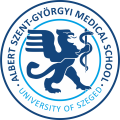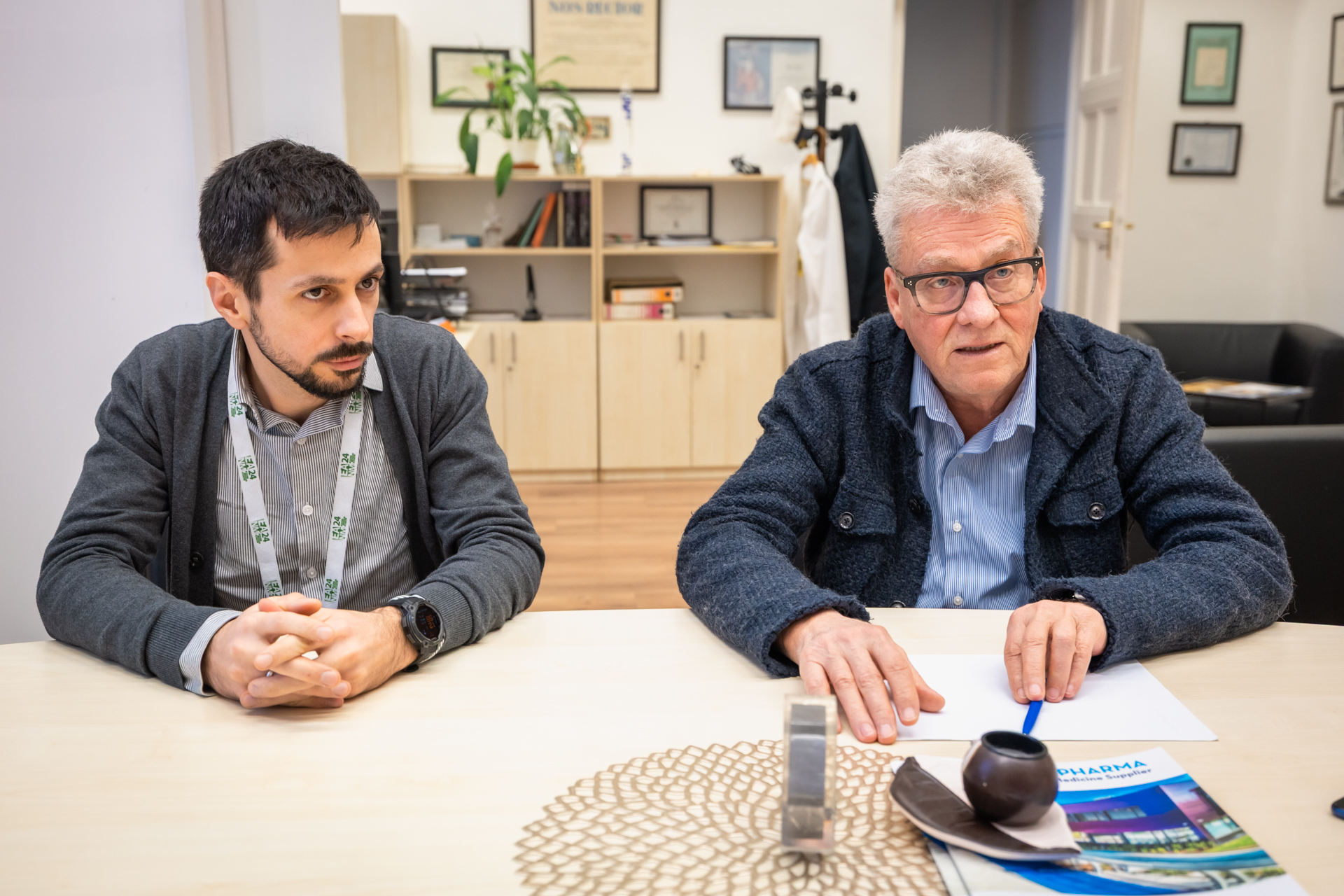University of Szeged
Albert Szent-Györgyi Medical School
Foreign Students' Secretariat
Your Education. Our Mission.

Professor András Varró's latest award, the Miklós Jancsó Memorial Medal
01 June 2022
The latest award of Professor András Varró has been the "Miklós Jancsó Memorial Medal", perhaps the most prestigious award in Medical Biology at the University of Szeged (SZTE). We talked to the former head of the Department of Pharmacology and Pharmacotherapy at the Albert Szent-Györgyi Medical School, University of Szeged, and Head of the Cardiovascular Pharmacology Research Group at Eötvös Loránd Research Network at SZTE about his previous awards. We recalled generations of doctors, Nobel Prize-worthy research, the history of the university, as well as Professor Varró's heartfelt interests - in the centenary academic year of the University of Szeged.The award ceremony laudations summarised the most important events in his career and highlighted his main achievements. In the life of Professor András Varró, 2019 was an exceptional year, as he received three prestigious honours: the Béla Szőkefalvi-Nagy Scientific Award at the 30th award ceremony of the Foundation for Szeged; in March he was awarded the Hungarian Order of Merit Officer’s Cross, civilian division, and in May he was granted the Szeged Memorial Medal on the birthday of the city.

- The Miklós Jancsó Memorial Medal was established in 1968 by the Medical University of Szeged. The first recipient of the award was Béla Issekutz, founder of the Institute of Pharmacology and Pharmacotherapy at the university. Among the 42 recipients are the former President of the Hungarian Academy of Sciences, Szilveszter E. Vízi; the son of Miklós Jancsó, Gábor Jancsó; and your father, Vince Varró. What gives the prestige of the award?

- Does it also matter who the award is named after?

- It also matters when a prize reaches its recipient. I have heard it suggested that you should have been awarded the Miklós Jancsó Memorial Medal at the height of your career and success as a distinguished professor and researcher. Why do you think about that?

The importance of Miklós Jancsó's achievements is shown by the fact that his name came up during last year's Nobel Week. The 2021 Nobel Prize in Medicine was awarded jointly to David Julius and Ardem Patapoutian for their discoveries of temperature and touch receptors, and this research was closely related to Miklós Jancsó’s field of interest, the function and pharmacology of sensory nerve endings involved in transmitting heat and pain. In his lecture, Nobel laureate David Julius, a researcher living in the United States, spoke about the Hungarian roots of capsaicin research, highlighting the achievements of Miklós Jancsó, but he also mentioned Gábor Jancsó, who represents the third generation of the same family. In 1977, Gábor Jancsó published a significant paper in Nature titled Pharmacologically induced selective degeneration of chemosensitive primary sensory neurons. This article was also listed as reference in the scientific background material of the 2021 Nobel Prize in Medicine.
- You also spoke about this in the commemorative lecture at the presentation ceremony of your latest award.
- I used this opportunity to show that János Szolcsányi, a Jancsó student who had started to work on this topic as a researcher in Szeged and went on to study it at the University of Pécs, also made some discoveries that led to him and David Julius being nominated for the Nobel Prize together in 2015. Professor Szolcsányi passed away in 2018. Looking back in time, maybe if he had not died, Szolcsányi might as well have been awarded the Nobel Prize together with Julius in 2021.
Three generations of the Jancsó family have strengthened medicine in Szeged and contributed to the recognition of research conducted here. Miklós Jancsó Sr. was a professor of internal medicine in Cluj (Romania), who fled to Szeged together with the university, when they were exiled from there after World War I. Miklós Jancsó Sr was involved in malaria research and chemotherapy and he became the first director of the Department of Internal Medicine. The Miklós Jancsó Dormitory was named after him.

- The "first Jancsó" was succeeded by, among others, your father Vince Varró as the head of Internal Medicine. What did you learn about the Jancsó research method from him?
- At home, my father, of course, told me a lot of stories about the university. As a medical student he attanded lectures given by the son, the pharmacologist Miklós Jancsó. My father considered Jancsó, the young researcher, a genius. True, he admitted, he was not a "team player"; Miklós Jancsó could not work with more than two or three people. He would share the governmental support with the other members of his research team, but he did not take part in the activity of colleagues outside his inner circle.
- The Varró family came into the spotlight via their awards, as in the centenary year of the University of Szeged, 2021, your sister, Andrea Varró, Professor at the University of Liverpool, was awarded Honorary Doctorate of the University of Szeged, and you received the Researcher of the Year Award in the field of sciences. Your father, Vince Varró, was awarded the Jubilee Medal of the Medical School on the occasion of his 100th birthday. What are your personal memories of Miklós Jancsó, who your award was named after?
- Miklós Jancsó was my predecessor at the department. He died in 1966, when I was 12 years old. We never met. On the other hand, when I was a student, I used to go to German language classes given by Herta, Miklós Jancsó's first wife for ten years. Her room was full of family photos. They had got divorced by then, but she told me a lot of stories about their first meeting in the Berlin laboratory where she was working as Miklós Jancsó's assistant. She came to Hungary with him. The family lived in an apartment at the present-day Institute of Pharmacology and Pharmacotherapy, which also included the professor's office. In the late 1970s, when the new dormitory of the medical university was built, Herta and I often walked by, chatting in German. She would tell me about the young Miklós Jancsó and how the war had torn the family apart.
One of the most notable research topics at the Medical School is capsaicin research. The results come from the joint work of Miklós Jancsó, the pharmacologist, his second wife, Aranka Gábor, and his students in the post-war period. One of their children is the aforementioned Gábor Jancsó, who taught me at the university: he was a popular practice leader in anatomy. He later moved to the Department of Physiology, as a researcher and then as head of the department.

- How did you become head the department here?
- Jancsó’s successor, Professor Gyula Szekeres, completely changed the profile of the department: the heart became the focus of research. After graduation, as my father was one of the most influential professors, I did not want to stay in Szeged. I went to the Institute of Pharmaceutical Research in Budapest, then I was awarded a scholarship to the United States of America. After Indianapolis and Cincinnati, I went to England, Liverpool to be precise. Professor Gyula Papp invited me back to the University in Szeged in 1992, and I became head of the electrophysiology lab.
- You have worked together with internationally renowned experts - physiologist David Eisner in England, cardiologist Borys Surawitz in the US - but in your opinion, your research in Szeged has been the most successful. What would you highlight regarding your research?
- We changed the textbook knowledge about one of the potassium channels of the heart, which is important in arrhythmia research. We concluded that there was no point in developing the type of drugs to block the potassium channel that were designed in the 1990s. The drug would presumably have harmed patients. The success of our research into the development of new antiarrhythmic drug candidates is reflected by 21 publications and 7 patents. The analysis of the cellular mode of action of antiarrhythmic drugs, including amiodarone, has resulted in 60 publications and 3 book chapters. We have also studied donor hearts and characterised myocardial potassium channels. The results have been published in prestigious international journals, such as Circulation, Cardiovascular Research and Journal of Physiology. Otherwise, potassium channel blockade as a research topic has accompanied me throughout my career.
- When studying the myocardium and conducting research on cardiac arrhythmia, you used the patch-clamp technique associated with the Nobel Prize winner Bert Sakmann. "Sakmann's electrophysiological method is considered a milestone," you said in the spring of 2012, when the Nobel Prize-winning scientist visited Szeged for the first time. How has the application of this research method contributed to your career?
- Damage to the repolarisation reserve is a risk factor for ventricular fibrillation and sudden cardiac arrest. I am still working on this topic as the head of the Cardiovascular Pharmacology Research Group.

- As one of the most successful research physicians, you took on the position of Vice Rector for Science and Innovation at the University of Szeged from 2011-2014. At that time, a scientific conference with nine Nobel Prize winners was organised in Szeged. One of the later results of this event was the establishment of the National Academy of Scientist Education in 2022, the new dormitory of which bears the name of Bert Sakmann, who first visited Szeged in 2012. The friendship you developed with Sakmann also contributed to the fact that the German cell physiologist was accompanied to Szeged by Erwin Neher, with whom Sakmann shared the Nobel Prize for their discoveries on the function of cellular ion channels. This further increased the number of Nobel Prize winners visiting Szeged. What is the basis of the friendship between a Nobel laureate German cell biologist and a Hungarian professor working on the mechanism of action of drugs?
- Our friendship originates from our shared interest in history. In 2012, Bert Sakmann visited Szeged for the first time to attend a conference celebrating the 75th anniversary of Albert Szent-Györgyi's Nobel Prize. It was also the first time I had met him, although I had been using the research method associated with his name when experimenting in the laboratory. We have met several times over the recent years. As a result of the conference, the Foundation for the Future of Biomedical Sciences in Szeged was established, and I took on the role of chairman of the board of trustees. To my great pleasure, Professor Péter Hegyi succeeded in convincing Professor Bert Sakmann to take on the position of Director of education for the organisation. As Bert Sakmann has a keen interest in Hungarian history, we had lively discussions about history at our meetings. I have been interested in history since I was a student. The depth of this interest is shown by the fact that as a high school student in Szeged, in 1972, I won a TV quiz show in history. I'll also tell you: for a while I used to imagine my future as a historian.
- You are also familiar with the history of the University of Szeged. As a historian of science, do you think it is important for the talents of the National Academy of Scientist Education to meet Nobel Prize-winning scientists as students?
- I have no personal experience, so I don't know what it means for young people today to be at high school and hear a Nobel Prize-winning researcher’s lecture. They probably cannot understand the details of the lecture or the results of their research at this level, but it can have an impact on their experience of what a Nobel Prize-winning scientist is like. For example, I can remember the first time I saw a Nobel laureate in my life as a young research fellow in America.

- Is that the pinnacle of a research career? The Nobel Prize? What do other honours and achievements matter?






